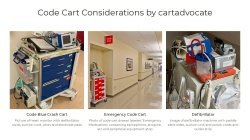Code Cart Considerations by cartadvocate

September 8, 2023 – El Dorado Hills, CA USA
Code Blue Crash Carts need an overhaul. While some environments of care support the use of existing code cart models, many do not.
Nurses use them frequently in acute cart hospitals and other healthcare facilities to respond to a patient in cardiac or respiratory arrest. Years ago I wrote an article on it here called, Code Blue Crash Cart Access. The next few posts I’m going to dive into, “Code Cart Mobilization.”
My medical cart research has lead to observation of an over abundant reliance on “The power cord.”
Each minute delay in resuscitation during cardiac arrest leads to a 7-10% decrease in success1.
1: Jacquet, G. A., Hamade, B., Diab, K. A., Sawaya, R., Dagher, G. A., Hitti, E., & Bayram, J. D. (2018). The Emergency Department Crash Cart: A systematic review and suggested contents. World J Emerg Med, 9(2), 93-98. doi:10.5847/wjem.j.1920-8642.2018.02.002
My hypothesis is that a uniform and standard power system could:
- Provide abundant cord free power
- Eliminate delayed code response due to cords
- Allow for monitoring of optimized powered cord cart fleet(s)
- Power all peripheral code cart equipment
- Streamline nurses / clinicians code readiness
- Improve code response times
- Mitigate damaged equipment and repairs from being tethered to the wall and falling off during emergency response (defibrillators, suction units, more…)
- Elevate infection prevention standards with no more cords on the ground or dangling all over the top and sides of carts
Using an evidence-based design approach, we will first look at existing research performed and available data surrounding the hypothesized “Problem.” That evidence will be published here.
Next we will look at innovative technology available involving wireless charging through contactless, anchored, and break-a-way systems.
Finally we will “Test” some of these solutions at a California university’s “Research and Simulation Lab” to perform simulated nurse usability studies of time and motion. This ensures nurse led innovation, human centered design, and hopefully significant improvements for nurse and clinician safety leading directly to improved patient outcomes during emergency code blue response.

I contend we can save lives by making nurses’ code blue response safer and more efficient while decreasing hospital’s cost of broken equipment and cords in a way that gives power transparency to an entire fleet of code carts which is agnostic to various peripheral equipment manufacturers (OEM makers of defibrillators, suction units, etc.). This would be a code cart overhaul worth consideration.
Subscribe to the feed here at cartadvocate to track my progress. If you are a nurse, hospital, or code cart manufacturer interested in contributing to my work please connect with me on LinkedIn.
For Your Medical Cart Solutions,
cartadvocate

